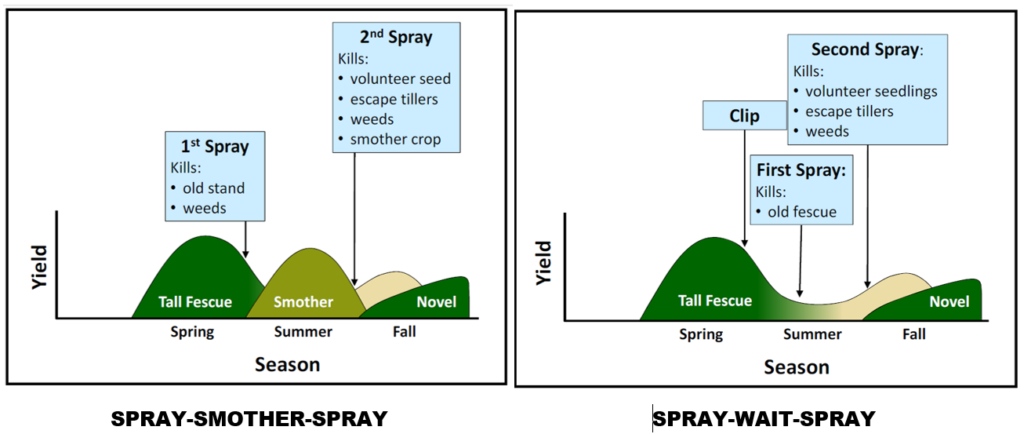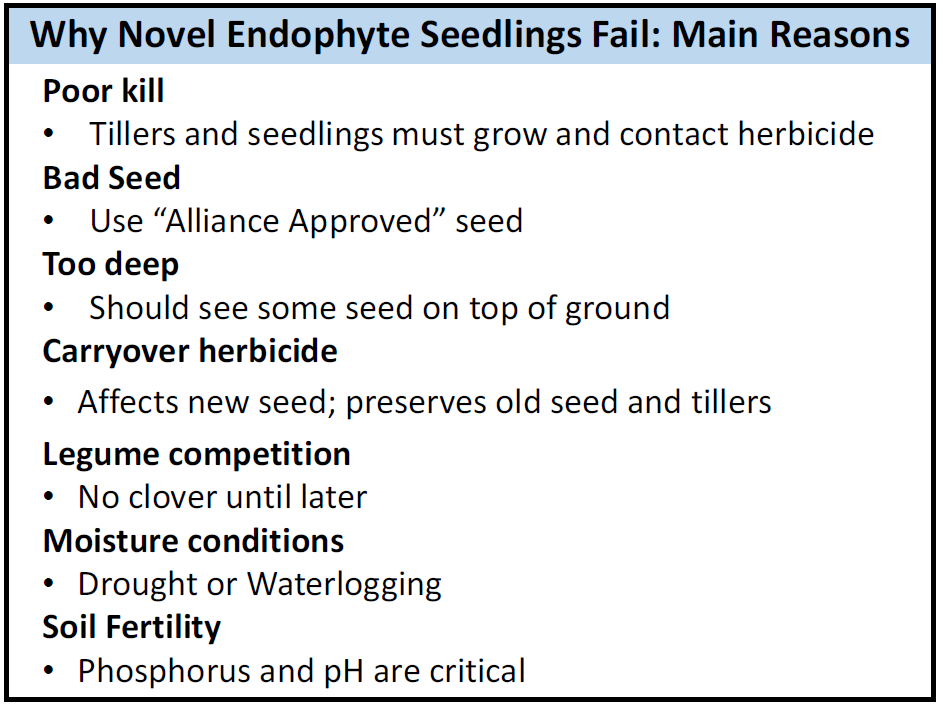(Part I of this series article can be found in the March 2021 edition of the Forage Team Newsletter.)
Conversion of toxic Kentucky-31 pastures and hayfields to a non-toxic, novel endophyte variety represents one of the most financially beneficial decisions available to livestock producers in areas where tall fescue is adapted. Research, over many years and locations has documented that consumption of tall fescue forage containing toxic compounds reduces both reproduction and growth. For cattle producers that means a reduced calving rate and lighter calves. “Fescue cattle” are likely to be discounted when marketed, further reducing the revenue from fewer pounds available for sale.
Replacement of existing stands of toxic tall fescue with non-toxic tall fescue infected with novel endophyte is the most certain procedure to overcome the liabilities and limitations to production resulting from tall fescue toxins.
Research has demonstrated that two applications of a non-selective herbicide are the most effective means to remove an existing stand of toxic tall fescue. Proper glyphosate application will effectively eliminate tall fescue vegetation. Proper application includes sprayer calibration. Recommendations are available from UGA for calibration of boom:
and boomless sprayers:
https://www.jocogov.org/sites/default/files/documents/PWK/boomlesscalibrate128.pdf.
Herbicide application will not prevent the establishment of toxic plants from “carry over” seed. Preventing the production of seed from the existing stand is essential to establishing a new stand of uniformly non-toxic plants.
Two accepted methods of removing the existing stand and establishing novel endophyte tall fescue are described in the figure below. In preparation for planting novel endophyte tall fescue, the area to be planted must have either been managed to prevent seed production (clipping seedheads) from an existing stand of toxic tall fescue [SPRAY-WAIT-SPRAY], OR the area was sprayed with non-selective herbicide (glyphosate) to eliminate existing plants and a warm-season annual forage was overseeded in late spring or early summer [SPRAY-SMOTHER-SPRAY].

Recalling guidance from Part I – “In the Piedmont and northern Georgia, UGA Extension recommends planting tall fescue between September 1 and October 15.” As soon as the decision to convert a stand to novel endophyte tall fescue, soil samples should have been analyzed and soil fertility amendments (lime to raise pH, P and K) should have been made.
If a warm-season annual was planted, it should have been grazed and/or hayed to adequately control the level of residue prior to spraying in preparation for fall planting of novel endophyte tall fescue. In addition to providing livestock feed, shading from the warm-season annual canopy will limit development of any toxic tall fescue seedlings that emerge from the seed bank. That canopy must be limited prior to the second glyphosate application to ensure good herbicide contact with any toxic tall fescue plants that have germinated and emerged. Maintaining some residue will provide soil cover and limit soil erosion while the new, novel endophyte stand is establishing.
The alternative approach to conversion is termed “spray-wait-spray.” A late summer glyphosate application reduces the exiting toxic tall fescue stand and a second application at planting time ensures the elimination of any escapes from the initial application. This approach depends on summer production from the existing toxic stand but has the advantage of delaying a planting decision.
Seed of a named variety, adapted to the locale, should have been reserved for pick up ahead of the intended planting date. Only certified seed of an established variety should be planted. It should also bear a tag of the Alliance for Grassland Renewal, assuring adequate infection with viable novel endophyte. Seed labeled as “low endophyte” or “endophyte free” should not be used. Seed from these sources will not persist and will likely result in stand loss within the second or third year.
Scheduling or preparing planting equipment is a vital step in preparation. For many producers the best option is renting a no-till drill from an equipment dealer or local conservation district. With rental equipment, schedule plenty of time to ensure that equipment is clean and operating properly. Procedures for drill preparation and calibration are available from UGA Extension https://secure.caes.uga.edu/extension/publications/files/pdf/B%201510_2.PDF. Drill calibration should insure distribution of seed at the proper seeding rate. Proper inspection and operation in also necessary to be certain seed is delivered at the proper seeding depth.
The following table from the Alliance reviews errors to be avoided in proper establishment of a new stand of novel endophyte infected tall fescue:

Stands planted in the fall should not be heavily grazed or hayed during the first spring. This is the period of most active growth of establishing plants and critical to long term persistence. Short-term, light grazing or haying could be conducted if plants are establishing well and growing conditions are favorable. Because novel endophyte tall fescue is no longer toxic, palatability will increase. Animals are very likely to consume more tall fescue than is typical with toxic plants. Grazing must be carefully monitored to avoid overgrazing. If cut for hay, be certain that a residue remains with at least a 4-inch stubble height.
Excessive grazing during the first summer can be very detrimental to stand persistence. Monitor and control weeds while the new stand is establishing.
It is unlikely that all stands of toxic tall fescue on an operation are converted simultaneously. This introduces the risk of contamination of newly established, novel endophyte stands with seed from toxic plants. Care must be taken to avoid introducing contaminated seed which could happen by feeding hay containing toxic seed or moving animals directly from toxic pastures with seedheads to novel endophyte pastures. Viable seed can pass through the grazing animals digestive tract and be deposited in manure.
Because tall fescue plants infected with the toxic endophyte are less palatable, if they become established in a pasture planted with novel endophyte tall fescue, they will be avoided during grazing and produce mature seed, further increasing the potential for contamination.
Following the first growing season, fertilizing for fall growth will contribute to good establishment of the new stand. Nitrogen will stimulate growth and adequate potassium will contribute to stand persistence.
The potential revenue benefits resulting from removal of toxic tall fescue and establishment of non-toxic, novel endophyte tall fescue are sufficient to justify careful preparation and planning, as well as proper planting and following management.